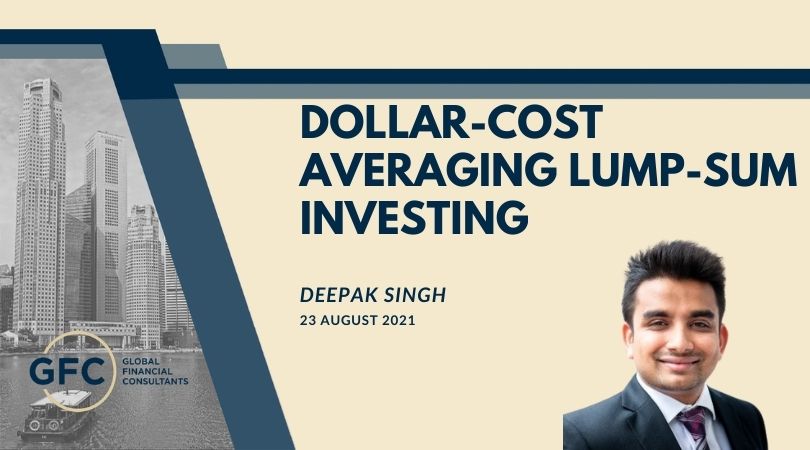
23 Aug DOLLAR-COST AVERAGING LUMP SUM INVESTING
Should I dollar-cost average or lump sum my investment funds? This is common conundrum investors face at the very beginning of their investment-making process.
The short answer is ‘it depends.
In this article, we shall discuss methodically the pros and cons of both of these investment approaches with the intention of guiding an investor towards the right direction based on your unique risk tolerance, future market expectations, financial situation, and investment objectives.
Dollar-Cost Averaging
Dollar-cost averaging is an investment strategy in which the total sum to be invested is divided up into periodic purchases of a target asset. The purchases occur regardless of the asset’s price and at regular intervals. As a result, this strategy eliminates the necessity of timing the market in order to make investments at the best prices. Dollar-cost averaging reduces the impact of volatility on the overall purchase.
Therefore, dollar-cost averaging is a highly effective tool any investor can use to build savings and wealth over a long period.
For instance, say you have accumulated $10,000 that you intend on investing into an index fund. Under this investment strategy, you would decide to invest $1000 per month over the course of the next ten months.
Lump-Sum Investing
Lump-sum investing is very simply an investment strategy of investing all of your available money at once. Using the example above, this would mean investing the $10,000 at once in a lump sum.
Pros of Dollar-Cost Averaging
Behavioral Biases
Dollar-cost averaging offers the benefit of eliminating many of the behavioral biases that may kick in when making an investment decision. This is decisive as it is undeniable that emotions and fear can be hard to separate when making an investment decision. As a result, investors can avoid making counterproductive actions based on greed or fear, such as purchasing more when prices are increasing or panic selling when prices are falling.
Timing the Market
By getting rid of the tedious process of attempting to time the market, dollar-cost averaging offers the psychological comfort of easing into the market.
Lower Investment Price
Investors who use a dollar-cost averaging strategy generally lower their entry price into an investment over time. The lower cost basis will lead to less of a loss on investments should they decline in price and generate greater gains if they increase in price.
Cons of Dollar-Cost Averaging
Higher Transaction Costs
Making smaller but more frequent transactions will lead to higher transaction costs, hence a higher expense ratio. These fees add up quickly and eat into returns, hence it has the potential of deviating you from realizing your investment objectives. In addition, every dollar spent on transaction cost is one less dollar that is left out on investing and compounding.
Foregone Gains
Dollar-cost averaging might lead to foregone gains, especially when markets are trending upwards at a rapid pace. As a result, you miss out on a full gain of a price increase should you have invested all your money initially as a lump sum. Considering that we have had a bull market for at least the last decade, investors who have dollar-cost averaged are more likely to have lost out on greater gains over time.
Pros of Lump Sum Investing
Lower Investment Costs
Investing all of your money at once results in lower transaction costs, as opposed to making multiple smaller investments through a dollar-cost investment strategy.
Greater Realisation of Capital Gains
Lump-sum investing will be advantageous during a rising market, as you’d be able to gain exposure right away to take full advantage of market growth. Lump-sum investing has been shown to outperform dollar-cost averaging over time.
Reduces the Opportunity Cost of Idle Cash & Longer Investment Horizon for Growth
If you have a large amount of money sitting idle, these funds are slowly but surely losing their purchasing value due to inflation and opportunity cost amongst other reasons. As a result, you’d be losing out on potential growth. By investing your money, you’d be able to put it to work immediately and allow the power of compounding to work its magic.
Cons of Lump sum Investing
Greater Risk
The obvious con of lump-sum investing is that you are essentially investing all of your available money right away. There is always the possibility that the market declines after you’ve made your investment, thereby exposing yourself to short-term risks and losses. In which case, just as how lump sum investors would be better off in bull markets, they would be worse off in bear markets. To mitigate such a risk, it’s critical to ensure that your portfolio allocation appropriately addresses your risk tolerance levels and investing goals.
What does Empirical Evidence Say?
Vanguard published a research paper in 2012 where they compared the historical performance of dollar-cost averaging with lump-sum investing across three key geographical markets: The United States, the United Kingdom, and Australia.
Without getting into the nitty-gritty of their findings, Vanguard concluded that lump sum investing has outperformed a dollar-cost averaging approach approximately two-thirds of the time. If an investor were to expect a similar long-term upward market trend to continue, is satisfied with their asset allocation, and is comfortable with the risk/return of their strategy, the prudent action would be to invest the lump sum immediately to gain exposure to the markets as soon as possible. However, if an investor is primarily concerned with reducing short-term downside risk and the potential for regret, then dollar-cost averaging may be a better alternative.
For a full reading of Vanguard’s research paper, refer to https://static.twentyoverten.com/5980d16bbfb1c93238ad9c24/rJpQmY8o7/Dollar-Cost-Averaging-Just-Means-Taking-Risk-Later-Vanguard.pdf
The Bottom Line
When deciding between investing all your money now as a lump sum or over time by dollar-cost averaging, it is always better to invest it now. Generally, the longer you wait to deploy your capital, the worst off you will be. This holds for all asset classes, time periods, and nearly all valuation regimes.
The only time you are better off by dollar-cost averaging would be when there is a declining market. However, most investors would be hesitant to invest in a falling market, which is why most investors will be unable to diligently stick to their strategy.
Based on historical performance, lump-sum investing has outperformed dollar-cost averaging. However, if you have doubts or worry about investing your lump sum today, it may be because the portfolio that you are investing in is too risky for your comfort. In which case, it would be wise to revisit your targeted asset allocation to ensure that it appropriately addresses risk tolerance levels and investing goals.
Deepak Singh is an Authorised Representative of Global Financial Consultants Pte Ltd – No: 200305462G | MAS License No: FA100035-3
To book a complimentary meeting, and explore how we can assist you, please use the following details.
✉ deepak.singh@gfcadvice.com
☜ https://calendly.com/deepakadvisory/introductory-meeting-our-office
General Information Only: The information on this site is of a general nature only. It does not take into account your individual financial situation, objectives, or needs. You should consider your own financial position and requirements before making a decision.
*Please note that Deepak Singh is not a tax agent or accountant and none of the content outlined here should be taken as personal advice. You should consult your tax agent and financial adviser to review your current personal finances and financial goals to consider whether this strategy is appropriate for you.
References
https://www.investopedia.com/terms/d/dollarcostaveraging.asp
https://www.singsaver.com.sg/blog/dollar-cost-averaging-vs-lump sum-investing
https://www.unitunimelb.org/2021/05/12/dca-vs-lump sum-investing/
https://ofdollarsanddata.com/dollar-cost-averaging-vs-lump sum/

